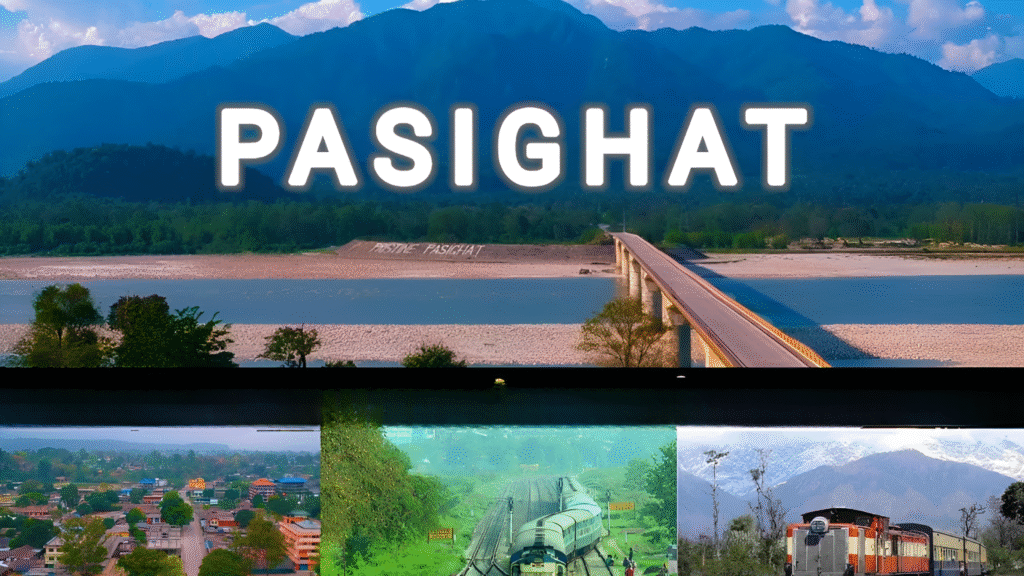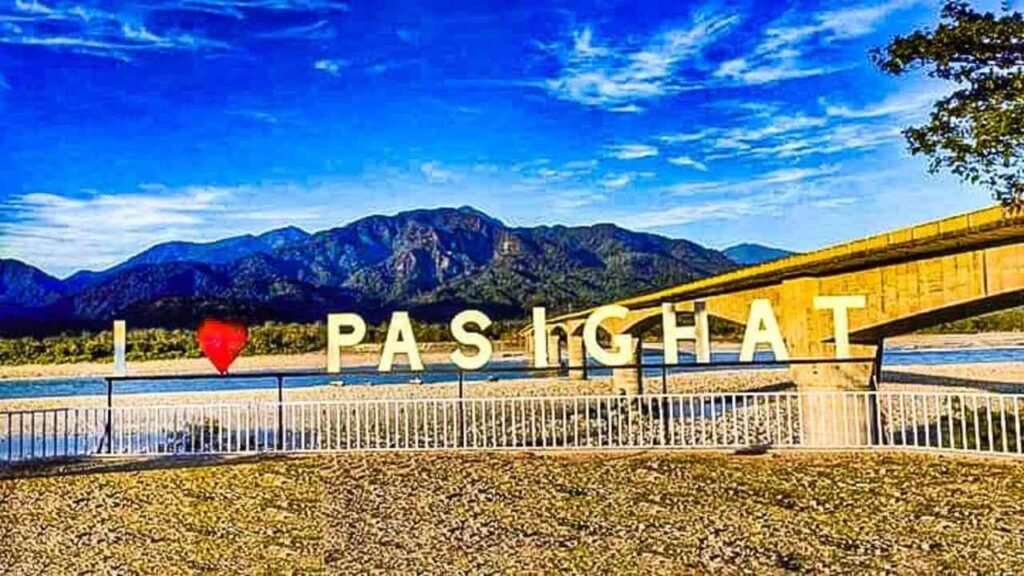Pasighat, the oldest town of Arunachal Pradesh, stands as a breathtaking confluence of nature, history, culture, and modern vibrancy. Founded in 1911, this celebrated “Gateway to Arunachal Pradesh” offers an immersive experience encompassing adventure, vibrant tribal traditions, and scenic wonders nestled alongside the Siang River in East Siang district.
Pasighat captures the essence of Arunachal Pradesh, verdant valleys, tribal festivities, serene rivers, and a vibrant pulse that beckons travellers, culture seekers, and explorers alike. Established by the British in 1911, it has blossomed into a hub rich with history, economic growth, and tourism delights. The town is more than just a scenic destination; it’s where tradition intertwines with the present.
Location, Connectivity, and Getting There
Pasighat lies at the foothills of the Eastern Himalayas in East Siang District, Arunachal Pradesh, at an altitude of 155 meters above sea level. The Siang River, a vital lifeline, enhances its charm and fertility.
How to Reach Pasighat
- By Air: Nearest commercial flights land at Dibrugarh Airport (167 km). From there, taxis and buses connect to Pasighat in about 3.5 hours.
- By Rail: The closest railhead is Murkong Selek, Assam, about 38 km from Pasighat, with regular connections to Guwahati.
- By Road: Well-maintained roads from Assam, especially via Jonai and Dhemaji, offer reliable access to the town.
Helicopter services and small airstrips provide additional access options, though most tourists arrive by road.
Key Details:
Travel Cost
Best Time to Visit
- October to May: Pleasant weather, festivals, and outdoor sightseeing.
- March, September: Cultural festivals (Aran, Solung, Etor) add vibrant local colour.
Historical Overview
The origins of Pasighat trace back to colonial pursuits. The British Raj sought a convenient gateway to the Abor Hills and laid the foundation for Pasighat as an administrative centre. The region is rooted in ancient Adi folklore, with settlements evolving amid clan disputes and subsequent integration of various Adi groups, including the Minyong.
After the British establishment, Pasighat became pivotal during the Anglo-Abor conflicts and was later developed through significant infrastructure, including airfields, educational institutes, hospitals, and the state’s first All India Radio station. Pasighat’s academic growth continued with the opening of colleges, fostering a rich intellectual and cultural life.
Vibrant Culture and Traditions
Pasighat is predominantly home to the Adi tribe, who imbue the region with colourful festivals (like Solung and Aran) and captivating dances, Ponung and the war dance Taapu. These folk celebrations mark harvests, communal harmony, and sacred rituals. The local dialects and handicrafts reveal the deep-rooted skills and oral histories of the Adi people.
The town’s festivals, warm hospitality, and communal practices define its unique social fabric. Cultural preservation is pivotal here, drawing increasing attention from travellers seeking authentic tribal experiences.
Tourism: A Paradise Waiting To Be Explored
Pasighat’s scenic grandeur is a major magnet for tourists. Adventure lovers, wildlife enthusiasts, and seekers of tranquillity find the town notable for its diversity:
- Daying Ering Wildlife Sanctuary
Located about 13 km from Pasighat, this sanctuary shelters rare fauna and offers birdwatching, boating, and nature trails. - Kekar Monying (“Hanging Bridge”)
A bamboo-and-cane marvel spanning the Siang, perfect for scenic views and connecting locals to villages. - Jerbom Yomgo River
A serene spot ideal for picnics, fishing, and soaking in the natural beauty near the town. - Pasighat Buddhist Temple
A spiritual retreat atop a hill, providing panoramic views of town and river. - Raneghat Suspension Bridge
This is an engineering feat that also serves as a vantage point for sunrise and sunset photography. - Bameng Fort
The ancient ruins are a testament to historic defence and local architecture. - Pangin and Sirki Waterfall
This place is notable for its crystal-clear waters and tranquil forests, perfect for outdoor adventures.
Tourism here also includes river rafting, hiking, village tours, and cultural festivals, making it a year-round destination.
The Economy: Agriculture, Tea, & Growing Trade
Agriculture forms the backbone of Pasighat’s economy, with rice as the staple crop nurtured by fertile Siang plains. Tea gardens dot the region, attracting workforces and supporting local livelihoods. In recent years, horticulture and tourism have rapidly contributed to the town’s economic vibrancy.
Trade has also expanded as infrastructure and connectivity improve, allowing local crafts, food products, and textiles to circulate more widely. The town’s development as a district headquarters has spurred the growth of service sectors.
Major Places to Visit in Pasighat

Modern Growth and Development
Pasighat has seen significant upgrades in education, medical facilities, and infrastructure, serving as a model for sustainable growth in the region. The establishment of institutions such as the Jawaharlal Nehru College and the College of Horticulture & Forestry has fostered a learning-centric atmosphere.
The recent inauguration of child safety homes and the implementation of smart policing reflect the town’s focus on social well-being alongside economic expansion. Collaboration with NGOs and new development policies continues to spur Pasighat’s transformation.
Demographics and Social Life
The 2001 census put Pasighat’s population at 21,972, with a majority being Minyong Adi people. Literacy rates are above the national average, showcasing the community’s focus on education. Social life thrives amidst traditional homes, bustling markets, and frequent cultural events.
Adis, with their rich oral traditions, are known for their warm hospitality and colourful attire, contributing vibrancy to every festival and daily gathering.
Current and Recent News
Pasighat continues to witness change and progress. In October 2025, a state-of-the-art child safety and healing centre named “Ane’s Home” was inaugurated, signalling its focus on social welfare, women’s safety, and community policing. Additionally, the implementation of smart policing and anti-drug strategies demonstrates a commitment to developmental stability and youth empowerment in the region.
FAQs About Pasighat
What makes Pasighat famous?
It is famous for being Arunachal Pradesh’s oldest town, its breathtaking landscapes, vibrant Adi tribal culture, and adventure sports opportunities.
Which are the best tourist spots in Pasighat?
Key spots include the Daying Ering Wildlife Sanctuary, Raneghat Suspension Bridge, Bameng Fort, Kekar Monying, Jerbom Yomgo River, and the scenic Pangin.
How does one reach Pasighat?
It is accessible by road from Assam, by rail to Murkong Selek, and by flights to Dibrugarh, the nearest airport. Local roads and seasonal helicopter services offer further connectivity.
What are the major festivals celebrated here?
The Adi people celebrate the Solung, Aran, and other vibrant dance and harvest festivals, marking the region’s agricultural and spiritual calendar.
What is the main occupation in Pasighat?
Agriculture remains the primary occupation, with rice and tea farming as chief contributors. Tourism and trade are rapidly gaining significance.
Is Pasighat safe for tourists?
It is generally regarded as safe for tourists, with new child safety and law enforcement initiatives ensuring comfort and peace of mind during stays.
What is the altitude and climate of Pasighat?
It sits at 155 meters above sea level, enjoying a subtropical highland climate with pleasant weather most months.
What role does Pasighat play in Arunachal’s economy?
It serves as an economic hub in East Siang, supporting agriculture, tea trade, emerging sectors, and acting as a regional market centre.
